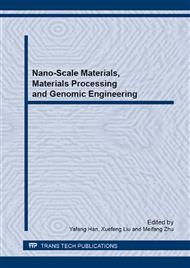[1]
R. Wirawan, S.M. Sapuan, Y. Robiah, A. Khalina, Flexural Properties of Sugarcane Bagasse Pith And Rind Reinforced Poly(Vinyl Chloride). Mater. Sci. Eng. (11)2010 1757-1761.
DOI: 10.1088/1757-899x/11/1/012011
Google Scholar
[2]
Y. Cao, S. Shibata, I. Fukumoto, Press forming of short natural fiber–reinforced biodegradable resin: effect of fiber volume and length on flexural properties. Compos Part A. (37)2006 423–429.
DOI: 10.1016/j.polymertesting.2005.07.012
Google Scholar
[3]
Y.T. Zheng, D.R. Cao, D.S. Wang, J.J. Chen, Study on the interface modification of bagasse fiber and the mechanical properties of its composite with PVC. Compos Part A. (38)2007 20–25.
DOI: 10.1016/j.compositesa.2006.01.023
Google Scholar
[4]
X. Fang, Y. Shen, J. Zhao, X. Bao, Y. Qu, Status and prospect of lignocellulosic bioethanol production in China. Bioresour Technol. (101)2010 4814–4819.
DOI: 10.1016/j.biortech.2009.11.050
Google Scholar
[5]
Z.Q. Huang, N. Wang, Y.J. Zhang, H.Y. Hu, Y.W. Luo, Effect of mechanical activation pretreatment on the properties of sugarcane bagasse/poly(vinyl chloride) composites. Compos Part A. (43)2012 114–120.
DOI: 10.1016/j.compositesa.2011.09.025
Google Scholar
[6]
V. Vilay, M. Mariatti, R. Mat Taib, M. Todo, Effect of fiber surface treatment and fiber loading on the properties of bagasse fiber–reinforced unsaturated polyester composites. Compos Sci Technol. (68)2008 631–638.
DOI: 10.1016/j.compscitech.2007.10.005
Google Scholar
[7]
L.Y. Mwaikambo, M.P. Ansell, Chemical modification of hemp, sisal, jute, and kapok fibers by alkalization. J Appl Polym Sci. (84)2002 2222-2234.
DOI: 10.1002/app.10460
Google Scholar
[8]
M.Z. Rong, M.Q. Zhang, Y. Liu, G.C. Yang, H.M. Zeng, The effect of fiber treatment on the mechanical properties of unidirectional sisal-reinforced epoxy composites.Compos Sci Technol. (61)2001 1437-1447.
DOI: 10.1016/s0266-3538(01)00046-x
Google Scholar
[9]
A. Valadez-Gonzalez, J.M. Cervantes-Uc, R. Olayo, P.J. Herrera-Franco, Chemical modification of henequen fibers with an organosilane coupling agent. Compos Part B. (30)1999 321-331.
DOI: 10.1016/s1359-8368(98)00055-9
Google Scholar
[10]
S.V. Prasad, C. Pavithran, P.K. Rohatgi, Alkali treatment of coir fibers for coir–polyester composites. J Mater. Sci. (18)1983 443-1454.
DOI: 10.1007/bf01111964
Google Scholar
[11]
X. Yanjun, A.S. Callum, X. HillZefang, M. Holger, M. Carsten, Silane coupling agents used for natural fiber/polymer composites: a review, Compos Part A. (41)2010 806–819.
Google Scholar
[12]
A.S. Moyeenuddin, L.P. Kim, A. Fernyhough, Effect of various chemical treatments on the fiber structure and tensile properties of industrial hemp fiber, Compos Part A. (42)2011 888–895.
DOI: 10.1016/j.compositesa.2011.03.008
Google Scholar


